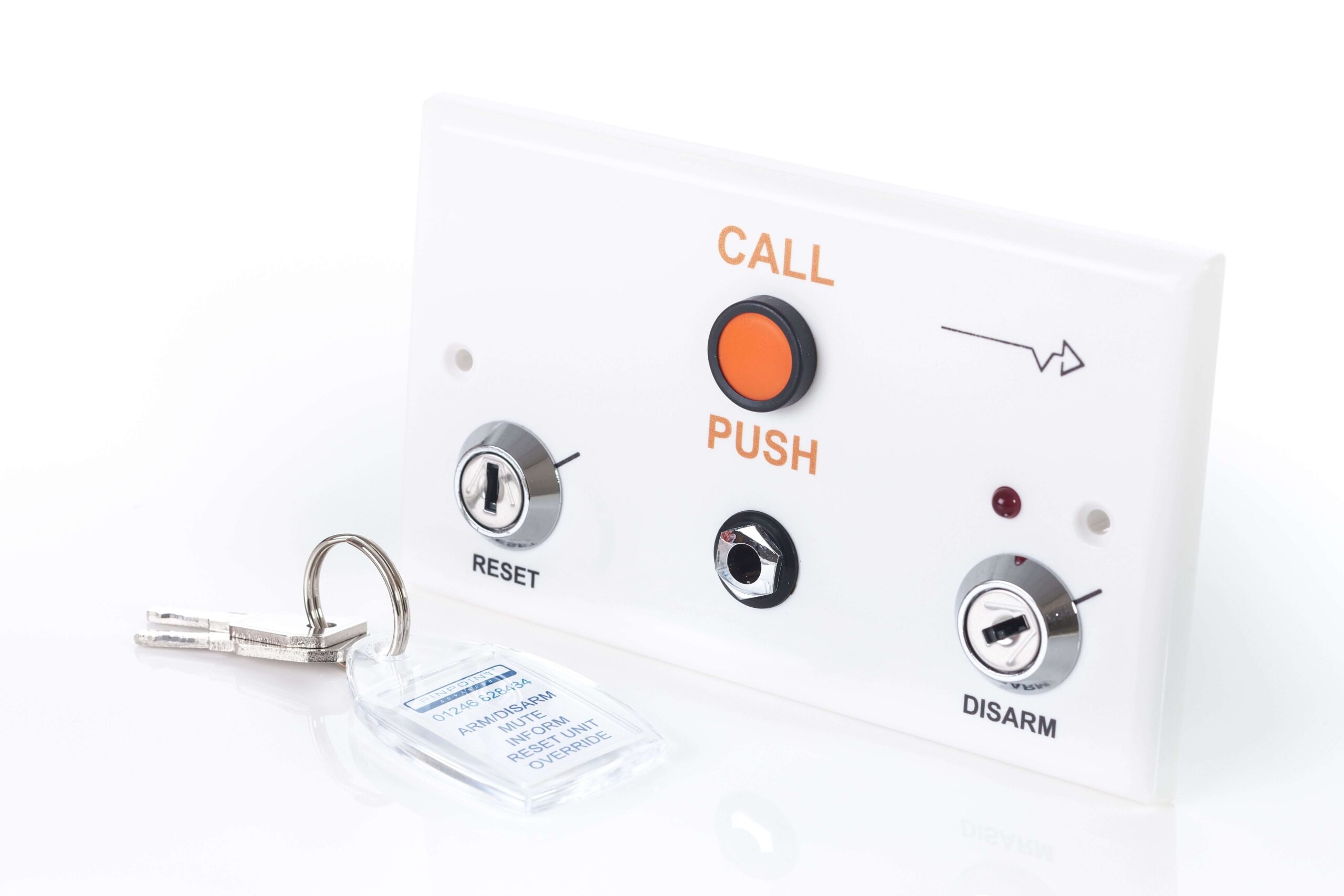Double Gang Addressable call button:
The Double Gang Addressable Call Button Unit can be set to emit any level of call (Patient Call, Emergency, Medical Emergency, etc). It is an independent unit that doesn’t rely on the use of connected addressable units, as it is set to have an address of its own.
The unit can be configured by using the Dil Switches on the back to set up an address or enable/disable the LED wink.
‘Addressable’ Call Button units do not need to be connected to an ARU. Instead, they have an address of their own which can be seen on a relevant Display when the Call Button has been triggered. They have a white fascia manufactured from ABS for maximum durability in harsh environments.
The exact configuration of the Call Button Unit varies, from model to model, to suit the requirements of the installation. The standard unit has a coloured Call Button relating to the level of call (Emergency, Patient Call, Assistance, etc) and a reassurance LED (which will flash to indicate the unit has been triggered). Various combinations of add-ons can be incorporated to suit customer needs, such as the addition of a Reset Key Switch (+481), a Disarm Key Switch (+482) or a Jack Plug Socket (+483).
The Call Button Unit should be mounted in a convenient place where it can be triggered quickly if needed. Consideration should be given to the condition of the surface to which the unit is to be mounted: it should be free from damp and moisture, not be subject to any shock or vibration, and be secure enough to allow a good fixing for the Call Button Unit and box.
Double Gang Wireless call button:
The Double Gang Wireless Call Button Unit acts as an external trigger to infrared receptive addressable units, such as the Addressable Receiver Unit (ARU). Much like a Personal Infrared Transmitter (PIT), but fixed to the wall, it transmits infrared in order to trigger an ARU in the same room.
The exact configuration of the Call Button Unit varies, from model to model, to suit the requirements of the installation. The standard unit has a coloured Call Button relating to the level of call (Emergency, Patient Call, Assistance, etc) and a reassurance LED (which will flash to indicate the unit has been triggered). Various combinations of add-ons can be incorporated to suit customer needs, such as the addition of a Reset Key Switch (+481), a Disarm Key Switch (+482) or a Jack Plug Socket (+483).
Wireless Call Button Units have a translucent black fascia manufactured from polycarbonate for maximum durability in harsh environments, allowing IR to pass through the fascia and trigger an ARU. When the battery is low, an on-board sounder will emit a ‘beeping’ sound to make the user aware that the batteries need changed - the battery should be changed as soon as the ‘battery-low beep’ has been heard.
The Call Button Unit should be mounted in a convenient place where it can be triggered quickly if needed. Consideration should be given to the condition of the surface to which the unit is to be mounted: it should be free from damp and moisture, not be subject to any shock or vibration, and be secure enough to allow a good fixing for the Call Button Unit and box. The associated, addressable unit should, ideally, be located as close as possible.
The Single Gang Programmable Call Button
The Single Gang Programmable Call Button Unit can be set to emit any level of call (Patient Call, Assistance and Emergency). It can feature a wireless reset switch that will reset the unit to its standby state - other options such as an Arm/Disarm Switch are available in place of the magnetic reset switch. The unit has an LED that re-assures the user that the unit has been triggered once the button has been pressed and highlights when the unit has been reset. Furthermore, the unit has a Normally Open (N/O) input for an additional method of Emergency Call, for example via pull cord.
If applicable, the unit can be reset by touching the Reset symbol using a wireless key-fob or the base of a Single Code PIT with Wireless Reset (316.15).
The unit can be programmed by using the Pinpoint Hand Held Programmer Unit (HHPU) to set up a range of settings, such as Call Level, Address and LED flash.
The Call Button should be installed at an appropriate height for its intended use where it can be triggered quickly if needed. It is not ‘waterproof’ and therefore is not intended for installation in shower/wet areas. Consideration should be given to the condition of the surface to which the unit is to be mounted: it should be free from damp and moisture, not be subject to any shock or vibration, and be secure enough to allow a good fixing for the unit and box.
The exact configuration of the unit varies, from model to model, to suit the requirements of the installation. The standard unit has a coloured Call Button relating to the level of call (Emergency, Patient Call, Assistance, etc), a reset function and a reassurance LED.
